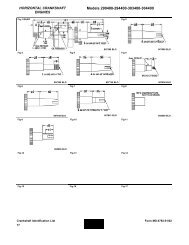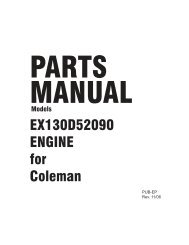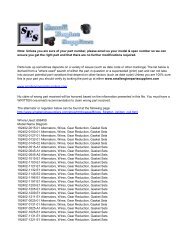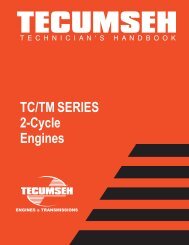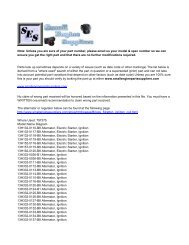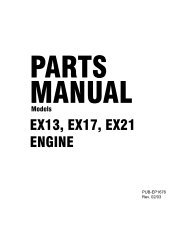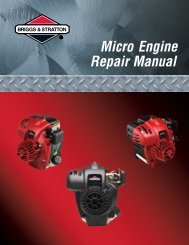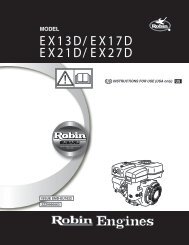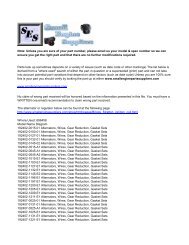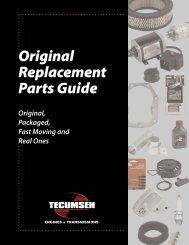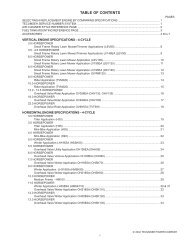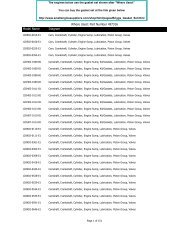3to 11hp 4-cycle l-head engines - Small Engine Suppliers
3to 11hp 4-cycle l-head engines - Small Engine Suppliers
3to 11hp 4-cycle l-head engines - Small Engine Suppliers
Create successful ePaper yourself
Turn your PDF publications into a flip-book with our unique Google optimized e-Paper software.
Diaphragm Carburetors<br />
1. Remove the screws holding the diaphragm cover on.<br />
2. Remove the cover, gaskets, and diaphragm noting or<br />
marking the sequence or location to aid in reassembly.<br />
NOTE: If a "F" designation on the choke end of the<br />
carburetor is present, place the diaphragm on first, then<br />
the gasket and cover. If no "F" is present, the gasket<br />
goes first.<br />
3. Note or mark the high and low mixture adjustment<br />
screws. Remove the screw assemblies.<br />
4. Note or mark the action of the choke and throttle<br />
shutters and the hook points of the choke or throttle<br />
return spring or seal retainer springs located on the top<br />
of the choke or throttle shaft. Remove the throttle<br />
shutter, throttle shaft, choke shutter, springs and choke<br />
shaft by removing the screw or screws that attach the<br />
throttle or choke shutter to the shaft inside the air horn.<br />
5. Use a 9/32" (7.144 mm) thin wall socket to unscrew<br />
and remove the inlet needle and seat assembly (diag.<br />
36).<br />
6. Note and mark the direction of the inlet fitting. If<br />
necessary the inlet fitting can be removed by pulling<br />
with a pliers or vise. Some diaphragm carburetors have<br />
a strainer as an integral part of the fuel fitting. If the<br />
strainer is lacquered or cannot be cleaned, the fitting<br />
must be replaced.<br />
7. Remove all welch plugs if cleaning the carburetor.<br />
Secure the carburetor in a vise equipped with protective<br />
jaws. Use a small chisel sharpened to a<br />
1/8" (3.175 mm) wide wedge point. Drive the chisel<br />
into the plug to pierce the metal, then push down on<br />
the chisel to pry the plug out of the hole.<br />
NOTE: DO NOT REMOVE ANY BALL OR CUP PLUGS.<br />
"F" DESIGNATION<br />
"F"<br />
DIAPHRAGM FIRST NOT GASKET 36<br />
37<br />
IMPULSE FUEL PUMP<br />
To service, disassemble the pump by removing the four<br />
(4) screws. Clean all parts with a solvent and install a new<br />
kit which consists of a coil spring, gaskets and diaphragms<br />
(diag. 37 & 38).<br />
FLOAT ADJUSTING PROCEDURE<br />
All Tecumseh carburetors with an adjustable float require<br />
the correct float height to achieve the proper operation<br />
and easy engine starts. To check the float height, hold the<br />
carburetor in an upside down position. Remove the bowl<br />
nut, float bowl, and "O" ring. Place an 11/64" (4.36 mm)<br />
diameter drill bit across the top of the carburetor casting<br />
on the opposite side and parallel to the float hinge pin<br />
(diag. 39). The float must just touch the drill bit when the<br />
bit is flush with the edge of the float. If the float is too high<br />
or too low, adjust the height by bending the tab<br />
accordingly. If the required adjustment is minor, the tab<br />
adjustment may be made without removing the float and<br />
carefully inserting a small bladed screwdriver to bend the<br />
tab.<br />
OLD STYLE<br />
11/64" (4.36 mm)<br />
DRILL BIT<br />
NEW STYLE<br />
38<br />
Float sticking can occur due to deposits or when the fuel<br />
tank is filled for the first time, this condition can be quickly<br />
corrected by loosening the carburetor bowl nut one full<br />
turn. Turn the bowl 1/4 turn in either direction, then return<br />
the bowl to its original position and tighten the bowl nut.<br />
RIM<br />
39<br />
19



